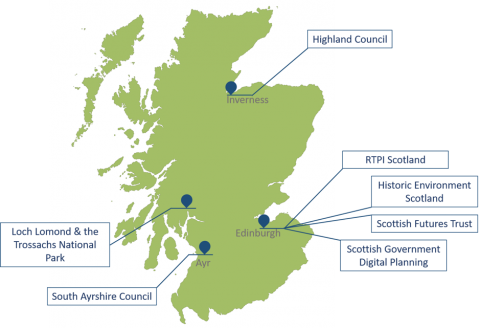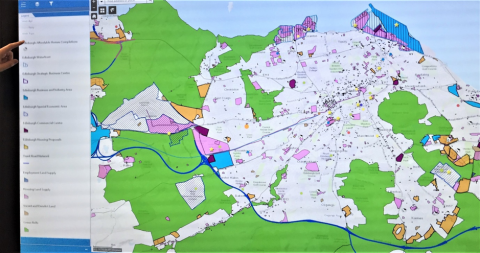
Submitted by Angela Walters on Fri, 31/05/2019 - 09:56
Franziska Sielker and Amarynth Sichel are researchers at the University of Cambridge Department of Land Economy working on the CDBB-funded project ‘Future Cities in the Making—overcoming barriers to information modelling in socially responsible cities’ that explores digitisation in the UK’s planning system. Following a visit to Scotland for meetings with stakeholders across the Scottish planning system, Franziska and Amarynth report on the range of projects and approaches to digitalisation in planning and asset management across the border.
A number of factors combine to make this a dynamic time for planning and digitalisation in Scotland. In 2016, a review in preparation for amending the planning system highlighted opportunities for digitalisation to help improve planning and a Digital Task Force was formed to create a first-rate planning system enabled by digitalisation. The 2017 Scottish BIM mandate brought focus to using digital tools for infrastructure management across the Scottish Government, which is in the process of redesigning the planning system through a new planning bill.
 Recent meetings with a number of stakeholders across the Scottish planning system (see and include fig 1) highlighted a range of projects and approaches to digitalisation in planning and asset management. The main theme emerging from our research in Scotland was the importance of rejuvenating the role of planning. What exactly should be done to digitalise the planning system, or what role technology providers should play in the country’s digitalisation processes is not yet clear, but our research reveals strong support for using digital tools to reinvigorate strategic planning.
Recent meetings with a number of stakeholders across the Scottish planning system (see and include fig 1) highlighted a range of projects and approaches to digitalisation in planning and asset management. The main theme emerging from our research in Scotland was the importance of rejuvenating the role of planning. What exactly should be done to digitalise the planning system, or what role technology providers should play in the country’s digitalisation processes is not yet clear, but our research reveals strong support for using digital tools to reinvigorate strategic planning.

Fig.1: Stakeholder interviews from Scotland case study
The Scottish Government’s Digital Planning team are currently prototyping different methods for visualising Scotland’s data (see and include figure 2). Visualisation tools can help identify pockets of investment, reveal patterns and trends, and providing decision-making support for planners and policy makers. Redesigning the planning user interface to make submitting an application a better experience can better facilitate public engagement, and is also on the agenda.
Scotland’s geography is another a factor shaping digitalisation. Highland is the largest local authority in the UK but it is sparsely populated, with only nine people per km2 recorded in 2012. To function effectively over such an expanse, Highland has adopted digital and mobile ways of working, embarking on a change process that altered the way work was shared across field offices.

Fig 2: Scottish Government Digital Planning team prototype
Many of the authorities we met recognise the importance of fit-for-purpose software systems and digital tools that integrate with one another so that, for example, different departments collecting information that informs future development plans can securely share data and deliver improved value and efficiency.
National-level organisations are also innovating with the use of digital tools and Building Information Modelling (BIM). Historic Environment Scotland (HES) has an ambitious BIM programme. Currently in the process of making its own organisation-wide BIM standards, HES is exploring how BIM and 3D modelling can serve conservation efforts. Scottish Futures Trust (SFT) is also actively engaged; aware that organisations and local authorities need a good business case to introduce BIM, SFT has created an online tool to help understand the upfront outlay BIM requires and the return on investment. This tool has gained popularity both inside and outside the UK.
Like other nations, Scotland faces a variety of resource constraints. However, these constraints have not prevented government, at the local and national level, from pursuing a digital agenda. While it is not possible at this stage in our research to identify factors that enabled Scotland’s digital drive, preliminary analysis suggests that more joined-up approaches to planning, with fewer divisions in decision-making competencies and responsibilities, facilitate cross-disciplinary coordination that transforms planning from a rote exercise to a strategic tool.
In the coming months we will finalise analysis on another two case studies and prepare recommendations to government on how to support local authorities in adopting BIM and other digital tools for planning. We look forward to sharing further results.
Read more about ‘Future Cities in the Making – overcoming barriers to information modelling in socially responsible cities’ at https://www.planningfuturecities.org/
